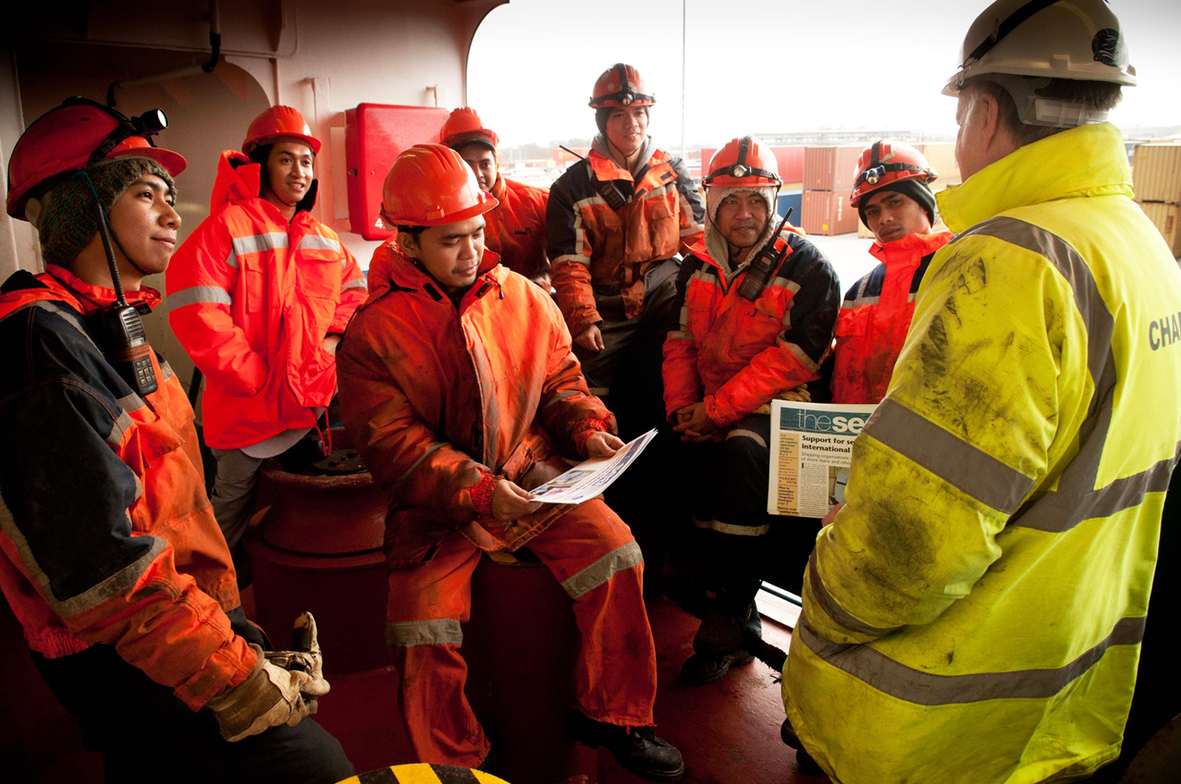For many years, whenever the Rev. Eric Phinney crossed the Harbour Bridge in Saint John, he would look out into the bay and feel a tug at his heart. The sea was calling to him.
It’s no wonder the sea is in his blood. His great grandfather, Hammon Evans, was a shipping agent, responsible for the welfare of seafarers.
“And my own father was a port engineer,” he said.
His father helped establish a rather no-frills spot for seafarers to telephone home — an upstairs room in Shed 8, where a payphone had been installed. That was in the 1970s.
Ed Coleman (now the Rev. Coleman) had just been commissioned in Church Army, and had spent the summer in Vancouver working with seafarers. He was told to come home and do the same thing here.
That was the foundation upon which the modern-day Mission to Seafarers was built in Saint John.
Eric didn’t go to sea. He went to divinity school and became a priest. But he learned to sail, has a sailboat, and in 2018, to celebrate his retirement, he and wife Val sailed Tevah from Saint John to the Bahamas.
But that retirement celebration was a bit premature. While he had been the port chaplain of the Mission to Seafarers for the past 10 years, he recently accepted the half-time position of regional director, overseeing port missions in all of Canada.
In addition, he is the half-time priest-in-charge in his old parish of Renforth. So he is back to full-time work, happily serving the needs of both parishioners and seafarers.
At an international conference of the Mission to Seafarers in Barcelona in October, he was pleased to discover many regional directors around the world also sail with their own boats.
MISSION TO SEAFARERS
“This is a branded Anglican mission — the largest Anglican mission, with 200 ports and 200 chaplains around the world,” said Eric. “This is our Anglican heritage.”
It was in 1836 that the Rev. John Ashley, looking out at ships in a nearby channel and wondering where all those sailors went to church, established a local mission. Twenty years later, building on his work, the Mission to Seafarers was born.
As the British Commonwealth grew, it took the Anglican Church with it around the world.
The Mission has a presence in 50 countries, all caring for the welfare of seafarers — the men and women who spend most of their careers away from home, on ships traversing the world delivering goods to port. The international headquarters is in London, UK.
Last year in Saint John, the Mission welcomed nearly 1,000 seafarers to their station, and visited 98 ships to provide hospitality and comfort to seafarers who remained onboard. All these services are offered with no strings attached and at no cost.
CARING FOR SEAFARERS
Seafaring is a unique calling, and it’s not for the faint of heart. It requires months away from home and family, sometimes working in less than ideal and isolating conditions.
Caring for seafarers takes three forms: a digital presence, when face-to-face contact is not possible, like at Saint John’s Canaport (deepwater crude oil terminal off the Fundy coast); visits to ships; and seafarer visits to their operation.
The Saint John station is housed at 92 Tilley Lane, next to the west side of the Harbour Bridge.
Seafarers have varied needs. Sometimes it’s a friendly face, a place to connect with family via phone or internet, some TV watching and snacks, and just the chance to get off the ship, away from the noise and demands of sea life.
“Seafarers have a special kind of visa to come ashore,” said Eric, adding it’s based on the Maritime Labour Convention of 2006 which allows shore leave, among other things. “Ports really like having an organization like ours because if we weren’t doing these things, they’d have to.
“Saint John has great access to everything they need. At the potash terminal, all they have to do is show their pass to the guard and walk uptown.”
But the Mission also has volunteers who pick them up and bring them to the station.
Other times, there is a much more pressing need. Eric remembers the Balsa 85 in port in 2015. Val saw on the news that 15 seafarers from the ship were in the Saint John Regional Hospital.
“I went straight to the Regional and was put with a nurse who took me to see each one of them,” he said.
It turned out fish caught in the Bahamas, which they ate that day, was the source of a neurotoxin which attacked all the bodily systems.
“I was able to reassure them, and then got them repatriated home to the Philippines.”
He’s been called on for much less daunting tasks as well, like helping a cook find onions, and taking seafarers for a drive just to see the sights.
He recalls grabbing some magazines from St. James the Less which the parishioners collect for the seafarers. He didn’t have time to go through them and a couple were aimed at female readers.
But that was a happy accident, because one of the seafarers saw an ad for a shingles vaccine, and told Eric he believed he had the illness.
That led to a trip to the Walmart pharmacist, who confirmed it. Eric helped that seafarer get home to deal with his illness off-ship.
SHIP VISITS
“Ship visits should be the most regular thing we do. It’s the best and most important way to connect, but logistics get in the way,” said Eric.
Many ships are only in port for 12 hours and leave with the tide.
“We have to organize visits based on that time,” he said. “They’re generally glad to see us. They’ve not seen anyone but themselves for a long time.
“We go in and talk to the captain, the first officer, the cook. We do a lot of active listening and observing. We’re looking for more serious, unspoken needs.”
Eric remembers a tugboat operator taking him out to a ship anchored at Canaport on Christmas day. He arrived with a bag of gifts and climbed aboard looking like a modern-day Santa Claus. While there he led a communion service.
SEAFARERS IN THE USA
While stops in the US are common, they are no longer popular. Seafarers have not managed to avoid the current administration’s seemingly arbitrary round-up of people they believe are illegal immigrants.
“They won’t leave their ships now,” he said. “Over 100 seafarers have been snatched and deported.”
In Baltimore, a seafarer requiring medical intervention was not permitted to leave the ship. And 12 seafarers involved in the bridge collision in Baltimore 18 months ago are still sequestered, unable to leave.
MISSION TO SEAFARERS IN CANADA
Eric, as regional director, is responsible for mission stations across Canada, from Atlantic Canada (St. John’s, Halifax and Saint John), through most of the St. Lawrence Seaway (Oshawa, Toronto, Hamilton, Colburg, Sarnia, Windsor and Thunder Bay) and the Pacific coast (Vancouver).
The Port of Montreal mission is operated by a non-Anglican group.
Some of his work involves making sure standards are adhered to and the brand is understood. He also ensures professional development and education are taking place, along with planning for the future.
“We take a careful look at where ships are going,” he said. “When we see more and more ships in a certain port, we ask, does it need a Mission? Right now I have my eyes on Churchill, Manitoba.”
He and the entire international mission are also tasked with studying the shipping industry and responding to changes, as they relate to the welfare of seafarers.
“We have to be acutely aware of the changes in the marine industry and how that impacts the Mission to Seafarers,” he said.
Part of the strategic plan for the Mission to Seafarers is to increase church engagement. Archbishop David Edwards is part of that, he being the liaison between the Mission in Canada and the Canadian House of Bishops.
“He helps raise the profile,” said Eric, adding he hopes parishioners in the diocese are receptive to learning about the Mission.
“I would love to see more understanding of what the Mission to Seafarers provides, and what seafarers provide,” he said.
“Ninety per cent of everything comes by ship. Every person in Canada should be aware of the people who supply their needs.”
HOW YOU CAN HELP
“This is a very important thing the Anglican Church does around the world,” said Eric. “It’s about justice, kindness.
“One thing I love about it is we get to go on ships, and with just a few resources, we can make enormous differences in people’s lives.”
But none of that can happen without help. The Mission is always looking for volunteers to open the Saint John station, make coffee, drive the van for pick-ups, take the seafarers shopping and provide home baking.
During the Santa At Sea program, they collect small gifts which are delivered to seafarers. Tony Dickinson, the Saint John station’s executive director, is looking for any of the following, which can be dropped off at their site, preferably by Dec. 15: shampoo, shave cream, toothpaste, tooth brush, dental floss, mouthwash, body wash, deodorant, disposable razors, lip balm, comb, hand lotion, facial tissues, hand sanitizer, gloves, socks, scarf, toque, playing cards, game books, pens, note pad, Canada souvenir (pin/magnet/key chain), candy (individually wrapped), chocolate bars, nuts, chips, gum, Christmas card.
Cash is always welcome too, so they can buy what they need. Do not wrap your gifts as they must pass inspection at the port.
For information on the Saint John station, click here.
For information on the worldwide Mission to Seafarers, click here.
PHOTO CAPTIONS:
1. Seafarers visit the Saint John station for relaxation, snacks and a chance to connect with family via phone and internet.
2. Th e Rev. Eric Phinney with Halifax Mission station manager Helen Glenn, national fundraising manager Marsha Klyn, and Dr. Desai Shan, a researcher from Memorial University, studying the welfare and health of seafarers. They were in Barcelona, Spain for an international seafarers conference in October.
3. A chaplain, in yellow, is always welcome on ships.
4. When seafarers visit the Saint John mission, they will find recreation, snacks and time and space to relax, call loved ones and just enjoy some time on land.
All photos courtesy of the Mission to Seafarers.


.jpg)



.jpg)

